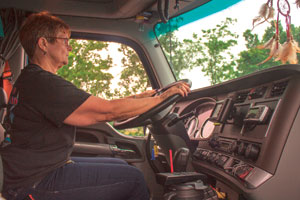Senior Reporter
FMCSA Announces Final Rules With Major Impact for Drivers

This story appears in the Dec. 12 print edition of Transport Topics.
Federal trucking regulators announced two long-awaited final rules last week, one setting up classroom and behind-the-wheel training requirements for new truck and bus drivers; the other to help motor carriers keep tabs on drivers shopping for jobs after they have refused or failed pre-employment drug and alcohol tests.
The entry-level driver training final rule, announced Dec. 7, dropped a controversial Federal Motor Carrier Safety Administration proposal earlier this year that would have required truck drivers to log at least 30 hours training behind the wheel to be eligible for the commercial driver license test.
Instead, the final rule requires that behind-the-wheel proficiency of an entry-level truck driver be determined solely by the instructor’s evaluation of how well the driver-trainee performs the fundamental vehicle control skills and driving procedures set forth in the curricula.
The rule, which will become effective Feb. 6 but won’t require compliance until Feb. 7, 2020, also does not require a specific number of hours of classroom instruction.
“However, training providers must provide instruction in all elements of the applicable theory curriculum, and driver trainees must receive an overall score of at least 80% on the theory assessment,” the rule said.
The agency said the behind-the-wheel curricula for Class A and Class B commercial driver licenses, consisting of range and public road segments, include “discrete maneuvers which each driver-trainee must proficiently demonstrate to the satisfaction of the training instructor.”
It also will require that training schools register with the FMCSA’s Training Provider Registry and certify that their program meets the classroom and driving standards.
“We’re pleased with the outcome of the final rule, T.J. England, chief legal officer for C.R. England Inc., told Transport Topics. “It strikes a good balance between safety and other considerations. We’re happy that the FMCSA decided to mandate some uniform standards.”
C.R. England, a refrigerated carrier, operates five driver training schools across the nation. The Salt Lake City-based carrier ranks No. 23 on the Transport Topics Top 100 list of the largest for-hire carriers in the Unites States and Canada.
Bill Sullivan, vice president of advocacy for American Trucking Associations, called the new driver rule “a victory for common sense and for safety.”
The proposed requirement was that drivers must complete at least 30 hours training behind the wheel, which would have prohibited skilled drivers from training fewer hours. The requirement was dropped.
Don Lefeve, president of the Commercial Vehicle Training Association, said the new driver training requirements “recognize the value and importance of effectively training commercial drivers based on their actual performance.”
“This rule ensures that students can only sit for their CDL exam after demonstrating driving and knowledge proficiency,” Lefeve said.
The drug and alcohol clearinghouse final rule, announced Dec. 2, also was years in the making.
In addition to checking the database for driver applicant drug and alcohol test failures, the rule requires employers to check the database to determine whether current employees have incurred a drug or alcohol violation that would prohibit them from performing “safety-sensitive” functions.
The clearinghouse rule goes into effect Jan. 4 but does not require compliance until Jan. 6, 2020.
“FMCSA believes three years is necessary to provide the agency time to design and implement the information technology systems needed to facilitate the reporting of results and violations of the drug and alcohol testing rules and the responses to queries from employers and prospective employers,” the agency said.
Motor carriers, medical review officers, third-party administrators and substance abuse professionals are required by the rule to report information about drivers who test positive for drugs or alcohol, refuse drug and alcohol testing and undergo the return-to-duty drug and alcohol rehabilitation process. Failure to do so can result in civil or criminal penalties.
The rule will require that a driver applicant give consent before a carrier can run his name through the central repository.
Also, the rule allows an employer to insert a report into the clearinghouse when the employer has “actual knowledge” that a driver has engaged in on-duty or before-duty alcohol use, used alcohol prior to post-accident testing or used a controlled substance. However, the rule requires that the report be backed up by evidence.
Because the Department of Transportation has not authorized drug and alcohol testing based on hair samples, the rule precludes reporting hair test failures to the clearinghouse, ATA Director of Safety Policy Sean Garney said.
FMCSA said the rule will allow employers to “follow” drivers, regardless of how many times they change jobs, seek employment or apply for a commercial driver license in a different state.
“The way the system was set up we weren’t capturing the pre-employment drug failures,” said Rob Moseley, a Greenville, South Carolina, attorney who represents trucking companies, noting that the rule keeps somebody from “walking in the door at a trucking company, fail the drug test, and then walk across the street.”

